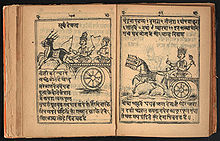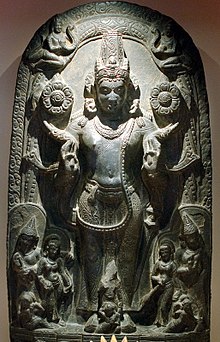Ratha Saptami
| Ratha Saptami | |
|---|---|
 Surya with consorts Saranyu and Chhaya | |
| Also called | Surya Jayanti, Magha Saptami |
| Observed by | Hindus |
| Begins | MaghaShukla Saptami |
| Frequency | Annual |
| Related to | Worship ofSurya |
Ratha Saptami(Sanskrit:रथसप्तमी,romanized:Rathasaptamī), also renderedMagha Saptami,is aHindufestival that falls on the seventh day (saptami) in the bright half (ShuklaPaksha) of theHindu monthMagha.[4]It is symbolically represented in the form of the sun-godSuryaturning hisratha(chariot) drawn by seven horses (representing the seven colours) towards the northern hemisphere, in a north-easternly direction. It also marks the birth of Surya and is hence also celebrated as Surya Jayanti (the sun-god’s birthday).[5]
Ratha Saptami is symbolic of the change of season to spring and the start of the harvesting season. For most Indian farmers, it is an auspicious beginning of the New Year. The festival is observed by all Hindus in their houses and in innumerable temples dedicated to Surya, across India.[6][7][8]
Background[edit]

Sun worship is deep rooted in theVedasof theHindureligion and its antiquity also relates to several mythologies of the world such as that of China, Egypt and Mesopotamia. TheGayatri Mantrajapa– the sacredVedicchants toSavitr(the Vedic sun god) – is popularly recited by adherents. AsPuranic Hinduismevolved, the worship of the sun was consolidated.[7][8]
In theRigvedaMandala 10/Hymn 85,the sun god's bride seated on a chariot pulled by two steeds is mentioned.
The relevant verses (translated from Sanskrit by Ralph Griffith) are as follows:
Her spirit was the bridal car; the covering thereof was heaven: Bright were both Steeds that drew it when Surya approached her husband's home.
Thy Steeds were steady, kept in place by holy verse and Sama-hymn: All cars were thy two chariot wheels: thy path was tremulous in the sky,
Clean, as thou wentest, were thy wheels wind, was the axle fastened there. Surya, proceeding to his Lord, mounted a spirit-fashionied car.
Religious significance[edit]
Ratha Saptami is symbolically represented in the form of the sun godSuryaturning hisrathadrawn by seven horses, withAruṇaas the charioteer, towards the northern hemisphere, in a north-easterly direction. The symbolic significance of the ratha and the seven horses reigned to it is that it represents the seven colours of therainbow.The seven horses are also said to represent the seven days of a week starting with Sunday, the day of Sun god Surya. The chariot has 12 wheels, which represents the 12 signs (each of 30 degrees) of the Zodiac (360 degrees) and constituting a full year, namedSamvatsara.The Sun’s own house is Leo (Simha) and he moves from one house to the next every month and the total cycle takes 365 days to complete. The Ratha Saptami festival seeks the benevolent cosmic spread of energy and light from the sun god.[6]
Ratha Saptami also marks the gradual increase in temperature across South India and awaits the arrival of spring, which is later heralded by the festival ofGudi Padwa,Ugadi,or the Hindu lunar New Year day in the month ofChaitra.
Legends[edit]
Ratha Saptami also marks the birth of Surya to sageKashyapaand his wifeAditiand hence celebrated as Surya Jayanti (the Sun-god’s birthday). A legend is narrated by theKamboja empire’s KingYashovarma,a noble king who had no heir to rule his kingdom. On his special prayers to God, he was blessed with a son. The king’s vows did not end with this, as his son was terminally ill. A saint who visited the king advised that his son should perform the Ratha Saptamipooja(worship) with reverence to rid of his past sins. Once the King’s son performed this, his health was restored and he ruled his kingdom well.[citation needed]
Sun temples[edit]

|

|

|
| Suryaidol atKonaraktemple | Sun Temple, Modhera | Arsavalli |
There are Surya temples all across India where Ratha Sapthami is fervently celebrated. However, the most famous one is theWorld Heritage Siteof theKonarak Sun Temple,inKonark,Odisha.Besides Konark, there is another sun temple in Odisha, theBiranchinarayan Temple, Buguda,Ganjam District.There are sun temples inModhera,Gujarat,created by king Bhimdev of theChaulukya dynasty,inArasavalli,Andhra Pradeshand in clusters ofNavagraha templesinTamil NaduandAssam.The Sun Temple atMartand(Jammu and Kashmir) andSun Temple of Multanare temples, which were destroyed by muslim invaders in the past.[6]
Religious observances[edit]

Vishnu,in his form asSurya,is usually worshipped on this day. Usually, Rathasapthami begins in households with a purification bath (bathing is also done in a river or sea) by holding several Ekka (Calotropis Gigantea) leaves on their head while bathing and chanting a verse which is supposed to invoke the benevolence of the deity in all that one indulges in during the rest of the year. Argyam or (Tharpanam) (water held in the palms) is offered to the sun god on this day while chanting hymns are performed to the sun god. It also involves doing apujawith the ritualNaivedhya(food offering to God), and offering of flowers and fruits. Important prayers offered to the Sun god on this occasion are theAdityahridayam,Gayathri,Suryashtakam,Surya Sahasram namam.The preferred time for the pooja is within one hour after sunrise.[6][9]In places likeMysoreandMelkote,ceremonial processions carry the SuryaMandala- the icon of Surya. [9]
Arka (inSanskrit,meaning a ray or flash of lightning) leaves,also called Aak in Hindi, Ekka (inKannada), Jilledu inTelugu,Erukku inTamilandCalotropis Gigantea(bowstring hemp) inEnglish.Arka is also a synonym for Surya or Sun. Its significance to sun god could be compared to the significance oftulasi(Ocimum tenuiflorum) leaves to Vishnu. Arka leaves are also used for worship of godGaneshaknown by the name Arka Ganesha and also forHanumanworship. Its stems, called samidha (sacrificial offerings of wood) are used for theyajnaritual as a sacrificial offering to a ritual fire. Its shape is said to represent the shoulders and chariot of sun god. Its use during the ritualistic ceremonious bath involves placement of seven leaves - one on the head, two on the shoulders, two on the knees and two on the feet.[6] On this day, inSouth India,Kolamis drawn with coloured rice powder depicting a chariot and seven horses as symbolic of the Ratha Saptami. Cowdung cake is also burnt at the centre of this depiction and milk boiled on the fire is offered to the sun god. In some of the importantVaishnavitetemples such as theTirumala,Srirangam,SrirangapattanaandMelukote,Ratha Saptami is one of the important festivals of the year. Theratha yatraof Veera Venkatesha of Sri Venkatramana Temple inMangaloreis held on this day and is famously known as Kodial Teru or Mangaluru Rathotsava.
Tirumala[edit]
On Ratha Saptami, a one-dayBrahmotsavamis held inTirumala.On this day, themurtis of the presiding deity of Malayappa Swamy, along with his divine consortsSrideviandBhudevi,are taken to a procession in the processional streets in Tirumala. The images circumambulate the shrine ofVenkateshvaraon seven differentvahanas. Due to this reason, the day of Ratha Saptami is regarded to be a minorbrahmotsavamin Tirumala.[10]
See also[edit]
- Other Sun festivals
References[edit]
- ^"2015 Hindu Festivals Calendar".
- ^"2017 Marathi Panchang Calendar".Retrieved2016-10-22.
- ^"January 2018 Marathi Panchang Calendar".Retrieved2017-10-05.
- ^"Ratha Saptami 2013 Date".hindusphere.Retrieved30 January2013.
Ratha Saptami falls on the Magha Sukla Paksha Saptami i.e on the seventh day of the wa xing phase of the moon in the month of Magha.
- ^"Tirumala TTD Ratha Saptami Ardha Brahmotsavam 2019 Schedule".TTO.7 February 2019.Retrieved7 February2019.
- ^abcde"Rathasaptahmi".Scribd.Retrieved2009-11-26.
- ^ab"Hindu Fasts and Festivals".Ratha Saptami.Retrieved2009-11-26.
- ^abNarayan, K.K.V (2007).Flipside of Hindu Symbolism: Sociological and Scientific Linkages in Hinduism.Fultus Corporation. p. 26.ISBN978-1-59682-117-0.Retrieved2009-11-26.
{{cite book}}:|work=ignored (help) - ^ab"Mysore, Melkote witness Ratha Sapthami processions".Mysore Samachar.Retrieved2009-11-26.
- ^K, Kandaswamy (28 August 2021)."Ratha Saptami in Tirumala Tirupati".Live Trend.K Kandaswamy.Retrieved28 August2021.
- ^"Ratha Saptami - Arasavalli,rathasaptami arasavalli".
